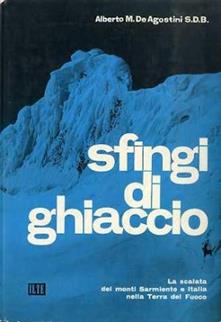 Sfingi di ghiaccio
Sfingi di ghiaccio

“Un ritorno alle montagne della Terra del Fuoco, che per tanti anni erano state la mèta prediletta de’ miei viaggi e delle mie esplorazioni, mi sembrava un sogno. E il sogno si avverò nel gennaio del 1956…” Inizia così il bellissimo libro “Sfingi di ghiaccio” di Padre Alberto Maria De Agostini, pubblicato nel ‘58 in lingua italiana e spagnola, che racconta la spedizione alpinistica e scientifica che ha conquistato il Monte Sarmiento e il Monte Italia. L’impresa impegna alpinisti e scienziati per quarantatre giorni di tempeste e bufere, durante i quali rare aperture della coltre di nubi lasciano vedere la luce delle vette.
Con Padre De Agostini, il capo scientifico-tecnico prof. Giuseppe Morandini, il fisiologo dott. Luigi Sperti, l'ingegnere e geologo Arvedo Decima, le guide Luigi Carrel, Camillo Pellissier, Luigi Barmasse e Clemente Maffei Gueret, l'accademico del C.A.I. Carlo Mauri, l'operatore cinematografico Edmondo Raffaldi, il maggiore Artuto Ayala Arce, topografo, il radiotelegrafista Belisario Cabeza, l'andinista Michele Saavedra e il cuoco Angelo Gaez.
|
|
Sfingi di Ghiaccio, by Albert0 M. de Agostini, S.D.B. Turin: I.L.T.E., 1958. 235 pages. 104 photographs, of which 15 are color; 4 maps. Price 3,500 Italian lire.
Monte Italia, Monte Sarmiento are two ice sphinxes rising 7000 and 7900 feet out of the cold waters of the Tierra de1 Fuego, just 100 miles from Cape Horn. The account of their first ascent by an Italian expedition, led by de Agostini, is beautifully illustrated and written in a precise and elegant style. It is unfortunate, however, that de Agostini fills 100 pages of this book with a diary account of the attempted climb of Sarmiento from the north. He never left Base Camp, and, therefore, this part of the book lacks the insight of first hand experience and reads very much like an operations order. The interest of this book lies chiefly in the discovery of an unknown and fascinating land--‘a land of fiords and mountains where the average daily rainfall is one-half inch and where tropically thick vegetation is cut through by glaciers which empty into the waters of the straits. Movement below timberline is restricted by the thickness of the vegetation and the sogginess of the turf; above timberline is the realm of rock and ice completely devoid of life. The eternal wind and snow above 3000 feet produces a thick coating of porous ice feathers which make climbing extremely hazardous and dificult. Out of 57 days spent in the area, five were without snowfall.
Base Camp was established in the forest at sea level. Camp I was situated on a rock spur above the Lovisato Glacier, south of Monte Sarmiento.
From here the party spent a month trying to reach the north face. They rarely caught a glimpse of their objective through the clouds and to their great dismay, after thirty days of effort, and after reaching a point 1300 feet below the summit, a break in the clouds revealed an impossible ice cliff 1000 feet high. Here the attempt from the north was abandoned, and as time was running out, the expedition split up, One group remained to continue their assault on Sarmiento from the south, and the other group left for Monte Italia aboard the cutter “Chabunco.” The vivid and interesting description of their trip among the fiords and across the Brecknock strait where ,they fought huge waves of the Pacific for fifteen miles, is in sharp contrast to the preceding pages. It is full of anecdotes on the life of the people of the Tierra de1 Fuego, among whom de Agostini has spent most of his life, De Agostini then lets Luigi Barmasse, one of the climbers, give the account of the ascent of Monte Italia. This, and the account of the ascent of Monte Sarmiento by the other group (Maffei), is a story of dedication and extreme will-power which enabled them to overcome technical difficulties of the highest order. The description of the climbs is given almost foot by foot and makes good reading. Italia was climbed from Beagle Canal with one intermediate camp; Sarmiento, with a sustained effort of 16 hours from Camp I, with a bivouac in the middle of the south face.
Sfingi di Ghiaccio is a well-illustrated book, of particular interest to anyone wanting to learn more about the unknown and fascinating mountains of the Tierra de1 Fuego.
MARCO T. EINAUDI
THE AMERICAhl ALPINE JOURNAL 1961 |